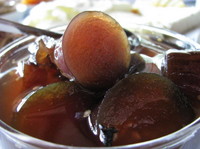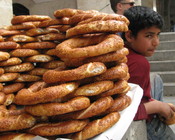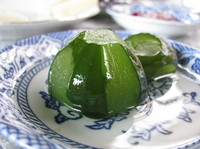Ten Turkish tastes
 It’s ridiculous to try to sum up Turkish cuisine in 10 flavours. Turkish cuisine is hugely rich and infinitely varied, not least because a) Turkey’s absolutely enormous – have you looked at a map recently? – comprising three different coastlines, high snowy mountains, very hot, dry plains and lush wooded hillsides, among other things, and b) its cooking has been influenced over the centuries by Mongolian, Chinese, Persian and Greek cultures and then, through the enormous Ottoman empire and its trade routes, many more, including Moroccan and French.
It’s ridiculous to try to sum up Turkish cuisine in 10 flavours. Turkish cuisine is hugely rich and infinitely varied, not least because a) Turkey’s absolutely enormous – have you looked at a map recently? – comprising three different coastlines, high snowy mountains, very hot, dry plains and lush wooded hillsides, among other things, and b) its cooking has been influenced over the centuries by Mongolian, Chinese, Persian and Greek cultures and then, through the enormous Ottoman empire and its trade routes, many more, including Moroccan and French.
But I’ll give it a go…
The first thing to say is that Turkish food is GREAT. We have eaten exceedingly well here numerous times, and have found all sorts of interesting ingredients and cooking/preserving techniques to get all excited about. Here are the 10 types of foods and drinks we came across again and again, and enjoyed each time:
 1) Tea
1) Tea
Despite being an unashamed coffee snob and addict, five weeks in Turkey has almost converted me to tea. This is because you can’t avoid it, and soon learn that no social meeting, business transaction or meal is complete without a glass or three of çay. Of course, Turkey used to be famous for its strong shots of thick coffee, but these days it’s glasses of tea you see all over the ‘café’ tables. Read more …
 2) Sugar
2) Sugar
Drinking tea all day has contributed towards to the sweet tooth I seem to have developed in Turkey, as the little glass is always served with two sugar lumps on the side. (Except in the Southeast, where you usually get three – Southeasterners liking their foods generally spicier, sweeter and tangier than their equivalents in the rest of the country.) Read more …
 3) Nuts
3) Nuts
We have found that sugar is often accompanied by nuts in Turkey, and they are as important as each other in the cuisine. Everyone knows which region grows the best of each kind of nut, and the nuts are often named after these places. We managed to visit several of them. Read more …
 4) Meat
4) Meat
It’s not all tea and candy in Turkey of course, and meat is a very important part of the diet for most Turks. Of course practically no pork – which was a nice change for us after our pork ‘n’ lard fest in central and eastern Europe. Beef and lamb are the most common red meats, with beef overtaking lamb, especially in the west, due to the increase of factory farming and hence smaller price tag. (Lower price in terms of pennies from the customer’s pocket that is, not cost to their health, the cows’ wellbeing or the environment, of course…) And there’s plenty of chicken too, but we found those dishes less interesting so I’m not writing about them here. Read more …
 5) Wild greens
5) Wild greens
Don’t fall into the trap of thinking Turkish food is just meat and kebabs, despite what you may have seen on your local highstreet in England. Some of the best cooking we had in Turkey was totally vegetarian. Three of or favourite cooks in Turkey, Musa Dağdeviren, Zeliha İrez and Erhan Şeker, cooked predominantly with vegetables, and made abundant use of weird and wonderful wild greens and herbs that we’d never heard of before, let alone tasted. Read more …
 6) The aubergine
6) The aubergine
If there is one vegetable that symbolises the Turkish kitchen it has to be the shiny, purple aubergine (patlıcan). It may not be native to Anatolia or even the wider Mediterranean (it was native to India and probably reached what is now Turkey in the Middle Ages), but it certainly suits the climate well and has become the representative, ‘traditional’ vegetable of the whole region. We had aubergine prepared for us in numerous delicious ways. These were some of our favourites: Read more …
 7) The pepper
7) The pepper
As ubiquitous as the aubergine is the pepper (biber), in all its versions: red hot chilli peppers, fat bell peppers and numerous thinner green varieties. The fresh green pepper – longer, thinner and paler than a regular bell, and sometimes with some pleasing heat – must be used in 8 out of 10 savoury Turkish dishes. It adds a wonderful fresh pepperiness (for want of a better word) to meat stews, vegetable meze, egg dishes and more. Its fatter bell cousin is usually stuffed with rice and flavourings. But it was the chilli that we were interested in. Read more …
 8) Dairy
8) Dairy
You might not associate Turkey with dairy products in the way that you might France or Italy. But dairy is big business in Turkey, the country which
invented yoghurt and exported it to the world. There are also numerous cheeses and some very special butters and creams, and an ice cream you eat with a knife and fork. Read more …
 9) Wheat
9) Wheat
While you may well find rice or potatoes as the starch on your dinner plate, and plenty of dried beans and pulses cooked up in your stews, and even desserts, it is wheat that has to be the principal starch-provider of Turkey. After all, it was in ancient Mesopotamia, and probably around the modern-day town of Diyarbakır in eastern Turkey, that wheat was first domesticated by man more than 10 thousand years ago. Read more …
 10) Fruit
10) Fruit
A good Turkish meal ends with fresh fruit, often artfully presented in slices and wedges on the plate. You might get kiwis, strawberries, oranges, apples or any number of stone fruit when in season. But apart from this occasional appearance, fresh fruit is surprisingly hard to find. I could suppose that this is due to the long history and widespread custom of preserving fruit so it can be enjoyed all year, a taste for which the sweet-toothed Turks maintain to this day in cities and villages alike. Read more …
Oh dear, there’s lots I haven’t mentioned. Like olives and olive oil (unknown to the eastern half of Turkey but ubiquitous along the Aegean coast), and those little sour plums people snack on in April, and the miniature hamsi fish of the Black Sea, and tahini, and….

 Follow
Follow
Comments are closed